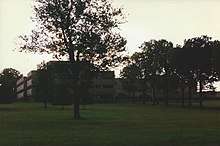AT&T Laboratories
AT&T Laboratories, Inc. was the research & development division of AT&T Corporation. It was founded in 1925 as Bell Telephone Laboratories, Inc., following the merger of the research & development divisions of American Telephone & Telegraph and Western Electric.
 AT&T Labs logo, 1999-2005 | |
Formerly | Bell Telephone Laboratories, Inc. |
|---|---|
| Division | |
| Industry | Research & Development |
| Fate | Absorbed |
| Predecessor | Bell Laboratories, Inc. |
| Successor | AT&T Labs |
| Founded | 1925 in Florham Park, New Jersey |
| Founder | Alexander Graham Bell |
| Defunct | 2005 |
| Headquarters | |
| Products | Multiple patents |
| Owner | AT&T |
Number of employees | 1,300 |
| Parent | AT&T Corporation |
| Website | AT&T Labs website under old AT&T |
History

In 1996, most of Bell Labs was spun off into Lucent Technologies, along with AT&T Technologies, formerly Western Electric, and the Bell Labs name. Research dealing with telephone equipment and most physical research went to Lucent.
But a smaller number of researchers dealing with voice technology, network management, and software stayed with AT&T Bell Laboratories, Inc., which was renamed AT&T Laboratories, Inc. Locations included Shannon Labs in Florham Park, New Jersey, and Middletown, New Jersey.
In 2005, SBC Communications purchased AT&T Corporation, and changed its own corporate name to AT&T Inc. The operations of AT&T Laboratories were then absorbed into SBC's R&D division, SBC Laboratories, which then was renamed AT&T Labs, Inc.